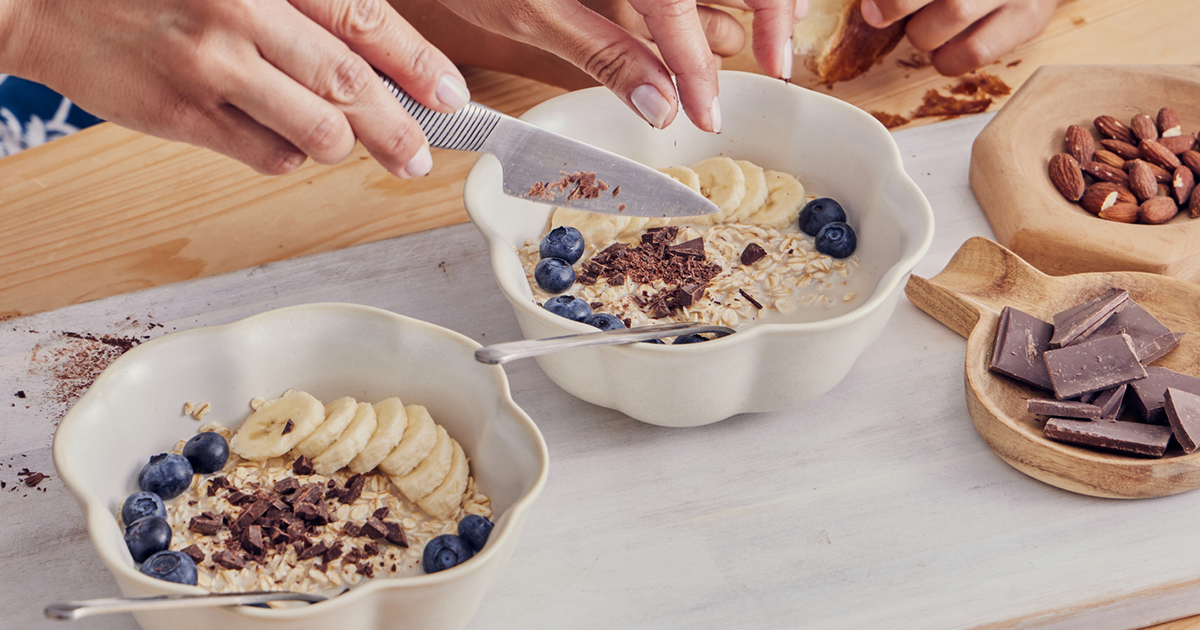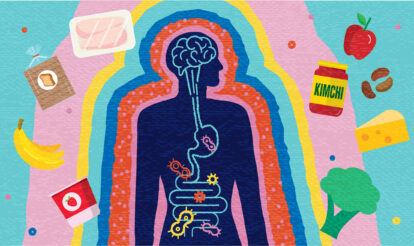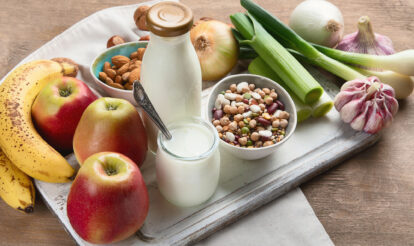
Top foods for gut health: a nutritionist’s guide
Top foods for gut health: a nutritionist’s guide

Few things shape our gut health more than our diet.
The foods we eat can help nourish beneficial bacteria, strengthen the intestinal lining, reduce inflammation, and maintain regularity.[1] Here’s an overview of how different nutrients contribute to gut health, and the best foods to include in your daily menu.
Soluble and insoluble fibre
Fibre is a type of carbohydrate that the body can’t digest. There are two types: soluble fibre absorbs water to form a gel that slows digestion and softens stools, while insoluble fibre acts as ‘roughage’, adding bulk to the stool and stimulating peristalsis.[2] Soluble fibre includes pectin, gums and mucilages, and insoluble fibre is made up of cellulose, hemicellulose, and lignin.
Fibre is essential for healthy gut function as it helps to balance intestinal pH and stimulates the fermentation of SCFAs (short-chain fatty acids). Fibre also binds with waste products and potentially harmful substances in the gut, allowing them to be moved out of the digestive system.[3] Resistant starch, another type of dietary fibre, fuels beneficial bacteria as well as supporting production of SCFAs.[4]
- Food sources of soluble fibre:
Fruits (apples, bananas, berries, pears, citrus); oats, barley, legumes (peas, beans); vegetables (broccoli, carrots, Brussels sprouts, kale, most root vegetables); chia seeds, flaxseeds, almonds, brown rice, rye.[5] - Food sources of insoluble fibre:
The outer skin of plants (cellulose, hemicellulose, and lignin). Corn bran, potatoes, and skins of apples, tomato, kiwifruit; green vegetables such as zucchini, green beans, celery, and cauliflower; whole grains, nuts and seeds.
Prebiotics
Prebiotics are also a type of carbohydrate that cannot be broken down in the gut, but unlike fibre, prebiotics are fermented by gut bacteria into a form of ‘fuel’ for gut bacteria such as Bifidobacteria and Lactobacillus.[6]
The most common forms of prebiotics are fructo-oligosaccharides (FOS), galacto-oligosaccharides (GOS), and trans-galacto-oligosaccharides (TOS). Fermenting these saccharides produces short-chain fatty acids (SCFAs) which have important health benefits. Lactic acid, butyric acid, and propionic acid are all types of SCFAs that support the integrity of the gut lining, provide energy to colon cells, regulate the immune system, and help reduce systemic inflammation.[7]
- Food sources of prebiotics:
Asparagus, garlic, chicory, onion, Jerusalem artichoke, wheat, honey, barley, tomato, rye, soybean, fermented dairy products, peas, beans, seaweeds and microalgae.[8]
Probiotics
Probiotic foods are foods produced by bacterial fermentation that contain live bacteria that help maintain a healthy gut microbiome. To provide these benefits, the probiotic strains must survive their journey through the upper digestive tract.[9] Yogurts and fermented milks have a relatively low pH environment in which the probiotic bacteria must survive.
It should be noted that the viability and effectiveness of probiotics within foods can be affected by temperature, acidity, bile, nutrient depletion, and oxidative conditions, which means they cannot provide the same quality and quantity of beneficial bacteria as probiotic supplements. However, probiotic foods still provide many health benefits for the gut.
Some research has suggested that consuming around 100 g/day of probiotic products can deliver a billion viable cells into the intestine on a regular daily basis.[10]
A 2024 meta analysis found that eating probiotic and prebiotic foods had significant benefits for gut health, which in turn resulted in benefits for stress levels, mood, and anxiety. People with constipation who regularly consumed probiotic-containing dairy products and prebiotics experienced more frequent bowel movements and a softer stool consistency.[11]
- Food sources of probiotics: Yogurt, cultured buttermilk, cheese, miso, tempeh, sauerkraut, sour dough, kimchi, olives, and pickles, kefir, soy based products, cereals, legumes, cabbage, maize, pearl millet, sorghum.[12]
Antioxidants
Many phytochemicals have important antioxidant and anti-inflammatory properties that support the gut. Carotenoids and Polyphenols are the phytonutrients that give fruits and vegetables their bright colours, and both have been shown to promote colonization of healthy bacteria. Some polyphenols act as prebiotics, fueling the function of probiotic bacteria while helping with bacterial communication.[13] Polyphenols also help to reduce numbers of pathogenic bacteria (including E.coli, Clostridium, and H. pylori). Gut bacteria also metabolize polyphenols into bioactive compounds that help regulate inflammation and stimulate tight junction proteins in epithelial cells, which strengthens the gut lining and reduces intestinal permeability.[14]
- Food sources of polyphenols: Apples, apricots, bilberries, black currant, broccoli, red cabbage, white cabbage, cauliflower, fruit juices, black tea, green tea, and red wine.
While prebiotics, fibre, probiotics, and antioxidants have similar benefits for the gut, they also have unique properties that nourish certain species or support different functions. Including a variety of food from each group in your daily diet is a great way to naturally support a healthy gut microbiome and intestinal integrity.
A simple way to do this could be to start your day with oatmeal, yoghurt and berries. Include both green and root vegetables with lunch and dinner, and add fermented foods such as kimchi, sauerkraut, garlic and onions. Snack on fruits and nuts, and drink plenty of green or black tea.
This content is for educational purposes only and is not a substitute for health professional advice.
[1] Aziz, T., Hussain, N., Hameed, Z., & Lin, L. (2024). Elucidating the role of diet in maintaining gut health to reduce the risk of obesity, cardiovascular and other age-related inflammatory diseases: recent challenges and future recommendations. Gut microbes, 16(1), 2297864. https://doi.org/10.1080/19490976.2023.2297864
[2] Barber, T. M., Kabisch, S., Pfeiffer, A. F. H., & Weickert, M. O. (2020). The Health Benefits of Dietary Fibre. Nutrients, 12(10), 3209. https://doi.org/10.3390/nu12103209
[3] Dhingra, D., Michael, M., Rajput, H., & Patil, R. T. (2012). Dietary fibre in foods: a review. Journal of food science and technology, 49(3), 255–266. https://doi.org/10.1007/s13197-011-0365-5
[4] Dhingra, D., Michael, M., Rajput, H., & Patil, R. T. (2012). Dietary fibre in foods: a review. Journal of food science and technology, 49(3), 255–266. https://doi.org/10.1007/s13197-011-0365-5
[5] Akbar A, Shreenath AP. High Fiber Diet. [Updated 2023 May 1]. In: StatPearls [Internet]. Treasure Island (FL): StatPearls Publishing; 2025 Jan-. Available from: https://www.ncbi.nlm.nih.gov/books/NBK559033/
[6] Gibson, G. R., & Roberfroid, M. B. (1995). Dietary modulation of the human colonic microbiota: introducing the concept of prebiotics. The Journal of nutrition, 125(6), 1401–1412. https://doi.org/10.1093/jn/125.6.1401
[7] Markowiak-Kopeć, P., & Śliżewska, K. (2020). The Effect of Probiotics on the Production of Short-Chain Fatty Acids by Human Intestinal Microbiome. Nutrients, 12(4), 1107. https://doi.org/10.3390/nu12041107
[8] Davani-Davari, D., Negahdaripour, M., Karimzadeh, I., Seifan, M., Mohkam, M., Masoumi, S. J., Berenjian, A., & Ghasemi, Y. (2019). Prebiotics: Definition, Types, Sources, Mechanisms, and Clinical Applications. Foods (Basel, Switzerland), 8(3), 92. https://doi.org/10.3390/foods8030092
[9] Terpou, A., Papadaki, A., Lappa, I. K., Kachrimanidou, V., Bosnea, L. A., & Kopsahelis, N. (2019). Probiotics in Food Systems: Significance and Emerging Strategies Towards Improved Viability and Delivery of Enhanced Beneficial Value. Nutrients, 11(7), 1591. https://doi.org/10.3390/nu11071591
[10] Karimi, R., Mortazavian, A.M. & Da Cruz, A.G. Viability of probiotic microorganisms in cheese during production and storage: a review. Dairy Science & Technol. 91, 283–308 (2011). https://doi.org/10.1007/s13594-011-0005-x
[11] Mori, N., Kano, M., Masuoka, N., Konno, T., Suzuki, Y., Miyazaki, K., & Ueki, Y. (2016). Effect of probiotic and prebiotic fermented milk on skin and intestinal conditions in healthy young female students. Bioscience of Microbiota Food and Health, 35(3), 105–112. https://doi.org/10.12938/bmfh.2015-022
[12] Syngai, G. G., Gopi, R., Bharali, R., Dey, S., Lakshmanan, G. M., & Ahmed, G. (2016). Probiotics – the versatile functional food ingredients. Journal of food science and technology, 53(2), 921–933. https://doi.org/10.1007/s13197-015-2011-0
[13] Dingeo, G., Brito, A., Samouda, H., Iddir, M., La Frano, M. R., & Bohn, T. (2020). Phytochemicals as modifiers of gut microbial communities. Food & function, 11(10), 8444–8471. https://doi.org/10.1039/d0fo01483d
[14] Dingeo, G., Brito, A., Samouda, H., Iddir, M., La Frano, M. R., & Bohn, T. (2020). Phytochemicals as modifiers of gut microbial communities. Food & function, 11(10), 8444–8471. https://doi.org/10.1039/d0fo01483d




